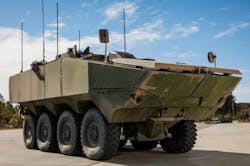Marine Corps asks BAE Systems to build an additional 26 ACV amphibious armored combat vehicles and vetronics
QUANTICO, Va. – U.S. Marine Corps amphibious warfare experts are ordering 26 more Amphibious Combat Vehicles (ACVs) and accompanying vetronics to replace the Corps's ageing fleet of amphibious assault vehicles (AAVs).
Officials of the Marine Corps Systems Command at Quantico Marine Base, Va., announced A $113.5 million contract Tuesday to the BAE Systems Platforms & Services segment in Sterling Heights, Mich., for 26 ACVs in a program called ACV 1.1.
The Marine Corps chose BAE Systems in 2018 as the ACV prime contractor over competitor Science Applications International Corporation (SAIC) in Reston, Va. BAE Systems won a $67 million order last June for three ACVs, and a $140.4 million order in December 2018 for 30 ACVs.
ACV re wheeled armored combat vehicles able to move Marine infantry warfighters from ships offshore to fight their way onto invasion beaches. Marine Corps leaders cancelled the expensive expeditionary fighting vehicle (EFV) program in 2011.
The Marine Corps could end up purchasing as many as 204 vehicles over the next few years to outfit some of its 10 amphibious assault companies — the first phase of an incremental approach to replacing the AAV, which entered service in 1972.
BAE Systems bases its ACV design on the Superav 8x8 amphibious armored personnel carrier developed by the Italian company Iveco Defence Vehicles.
ACV systems are designed to operate through enemy direct fire, indirect fire, and land mines with low-profile visual and infrared signatures, modular protection, and other armored vehicle technologies.
The vehicles can swim to shore from as far as 12 miles out to sea, switch from operating in the water to ground operations without pause, and then maneuver with M1 Abrams main battle tanks in a mechanized task force. The ACV can destroy relatively light enemy combat vehicles similar to itself.
The ACV will provide direct fire support for Marine infantry, and can carry 17 Marines at speeds of at least eight knots at sea amid three-foot waves with waves as large as three feet.
On shore, the ACV has high-ground clearance and a V-shaped hull to resist the effects of land mine blasts, and can operate with a wheel blown off.
Each ACV has a crew of three, an M2 .50 caliber machine gun in a remote weapons station, with the potential to install a stabilized dual-mount M2/Mark 19 grenade launcher turret.
On this order BAE Systems will do the work in York, Pa.; Aiken, S.C.; San Jose, Calif.; Sterling Heights, Mich.; and Stafford, Va., and should be finished by April 2022. For more information contact BAE Systems Platforms & Services online at www.baesystems.com, or Marine Corps Systems Command at www.marcorsyscom.marines.mil.
About the Author
John Keller
Editor-in-Chief
John Keller is the Editor-in-Chief, Military & Aerospace Electronics Magazine--provides extensive coverage and analysis of enabling electronics and optoelectronic technologies in military, space and commercial aviation applications. John has been a member of the Military & Aerospace Electronics staff since 1989 and chief editor since 1995.
